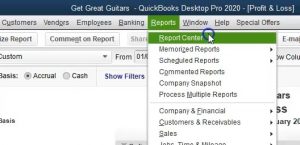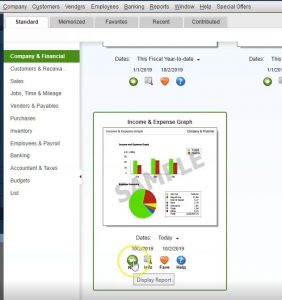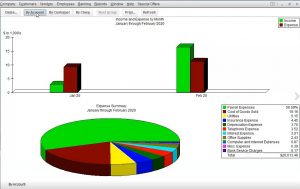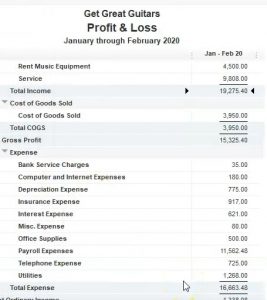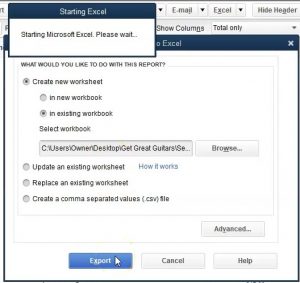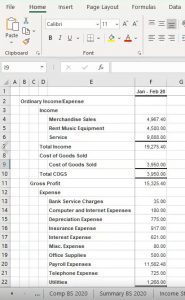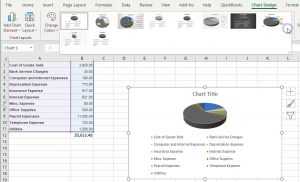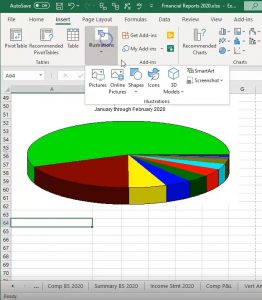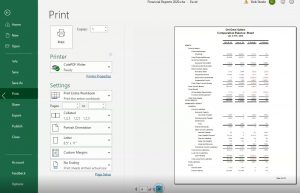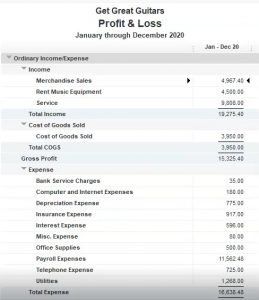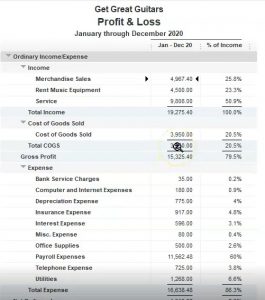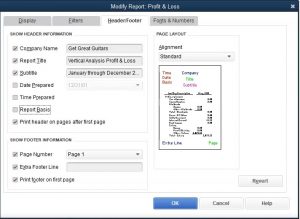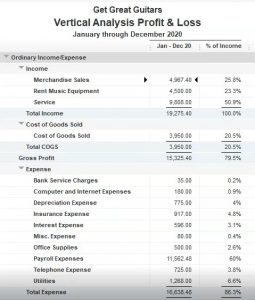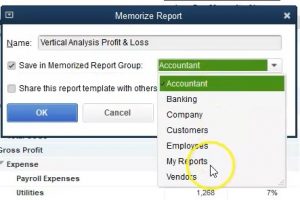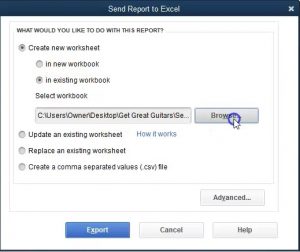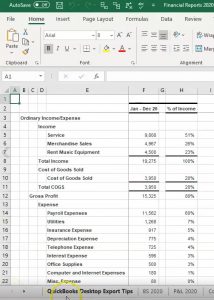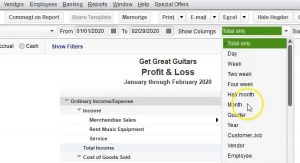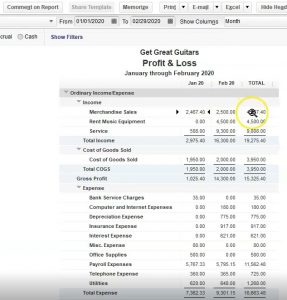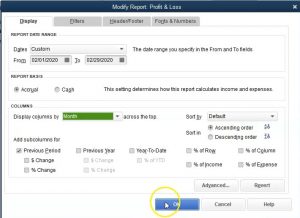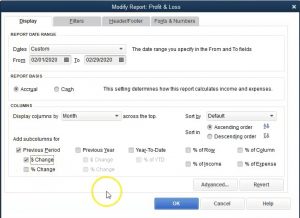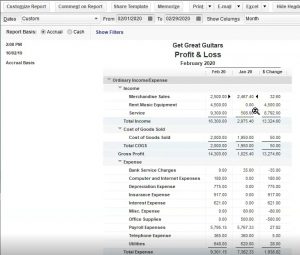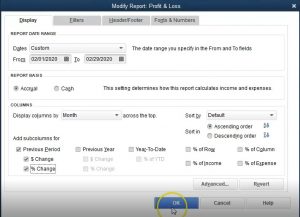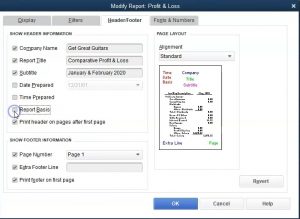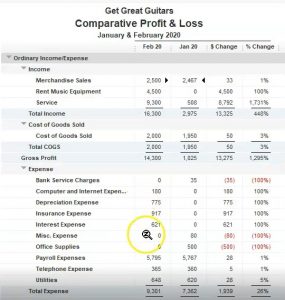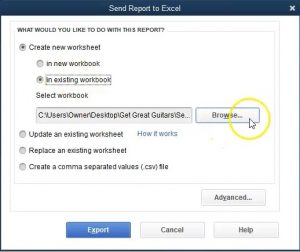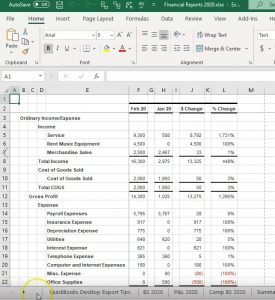This presentation, we will create a sales by item report within QuickBooks Pro 2020, QuickBooks desktop 2020. Here we are in our get great guitar file, we currently have the open windows open, you can open the open windows by selecting the view drop down and the open windows lyst. We’re now going to be creating a sales by item summary.
Sales by Customer Report 4.20
This presentation we will generate analyze Export to Excel and print a sales by customer report within QuickBooks Pro 2020, QuickBooks desktop 2020. Here we are in our get great guitars file, we currently have the open windows open, you can open the open windows by selecting the view drop down and the open windows lyst.
Income & Expense Graph 4.15
0:00
This presentation and we will create an income and expense graph focusing in on the expense graph within QuickBooks Pro 2020, QuickBooks desktop 2020. Here we are in our get great guitars file, we currently have the open windows open, you can open the open windows by selecting the view drop down and the open windows the list we’re going to be focusing in on and expense type of graph, we know that that will be supporting the documentation related to an income statement or Profit and Loss report.
0:28
Therefore, we’re going to start off opening up the profit and loss report by going to the reports drop down up top, selecting the company and financial and that profit and loss of standard report, we’re going to be changing the dates up top from a one on one to zero to two, let’s say oh two and 20 920 January through February 2020. Now we’re going to be considering our graph when I go into the grass, I tend to like to go into the report center. Therefore we’re going to go to the reports dropped down to the reports center.
0:58
We’re now looking for the correction I’m going to be in we’re in the standard section, I’m going to maximize the screen here. We’re in the standard tab, we’re in the company and financial tab, and then I’m going to scroll down I typically will just scroll down the reports that are graphs will usually be towards the bottom. Therefore, I’m just going to scroll down till I find the graph we are looking at for scrolling down we see here the income and expense graph.
1:25
That’s the one we want. Now we could change the dates, I typically will simply run the report and then change the dates within it. So I’m going to cheat, I’m going to run the report, then there’s nothing there. And I’m going oh no, what’s wrong? Well, it’s a date thing. Anything that time there’s something wrong, don’t panic. First check the dates, is there a date problem? Yes, there is we’re going to select the dates here. And we’re going to change the dates from
1:46
Oh 1012020 229 to zero, that’s January through February 2020. So we’re going to say Okay, there we have our graph. So we have the data up top, we have the graph that is either by account, or by customers. So we got the by account, or by customer or by class, we’re going to be focusing in on the account or customer, you can also change this graph to be an income graph by selecting the income item over here or an expense graph.
2:15
When you select the income side of things, we’re breaking this out, which will be specific related to the accounts that are up top. So we have by account or by customer, we have seen income or sales related graphs in a prior presentation. So we’re going to be focusing here on the expense side of things. But first, we’re going to switch back to the expense over here. So we’re back on the expense side, we’re on the expense side first by accounts expense by account.
2:40
So we see our expenses in the key over here, which of course are represented by the pie chart, we want to consider make sure we know where does that 20,006 13 tie into the profit and loss report. So if we go to the profit and loss report, we could say, All right, here’s the expenses. And there’s the total expenses, it doesn’t tie out, why not, because it also in lose the cost of goods sold. So just recall, just understand that it’s going to be the 1666 3.48 Plus, and then we take the 3950, that’s going to be the 20,006 1348.
3:15
That will be here. So we have the 20,006 1348. So so you can obviously basically generate this report as well from an essence of profit and loss report. So let’s do that real quick just to see what that would look like if we actually export this profit loss report to our Excel worksheet. Once again, if we go to Excel, and we create an Excel, a new Excel worksheet, we’re going to put it to the existing workbook. So we’re going to put that in the existing workbook, I’m going to say browse, there’s the workbook, I’m going to double click on that and export to it.
3:49
Here we have it, I’m going to do the same kind of things we normally do, I’m going to delete the prior tab, right click on it, delete it, I’m going to pull this number all the way to the right now I’m going to drag get all the way to the right. And so there we have it, I’m going to rename it, I’m going to call it an expense, graph and expense graph. So we’re going to make an expense graph from this just to regenerate it.
4:13
So you can see how this number is put together. And how you might want to create, it might give you some more flexibility to do. So first off, I’m going to go to the View tab on the second tab, say okay, and then I’m going to get rid of the split pains, we’re going to go to the View up top to do so we’re in the windows group, I’m going to remove the splits, removing the splits, then I’m going to go back to the normal tab. And I’m just going to take what we need, all we need are the expenses.
4:38
Therefore I’m going to delete everything out, I’m going to take the entire row and just go down the entire row highlighting the entire road let go right click on that selected area down to the expenses and delete it, we don’t need any of that. Actually, I’m going to undo that we do need the cost of goods sold, undo, we’re going to go the whole road down to the cost of goods sold. Don’t need the end, then delete, and right click and delete. So now we have the cost of goods sold on down, I don’t need the subtotal.
5:07
So I’m going to get rid of the sub totals, I’m going to get rid of the expense item here. So I’m going to delete those so that we don’t need any of those. And then I’m going to recreate the total down here. So I’m just going to delete all of this stuff, right click and delete. And so here’s all of our expenses, including the cost of goods sold, I’m going to highlight these three columns. I know I’m doing this fast, but just just an example here, and I’m going to delete this one. And so these are just our expenses now. So if we were to total this up in summing up all of the expenses, we then get to our 20,006 1348.
5:47
Now we can simply make a graph from this, I can just highlight this information, we can go to the Insert tab, we’re going to then go to the charts group, we’re going to make a pie chart, we can do the you know the one with a 3d pie chart. And so there we have it, there’s a 3d pie chart. And obviously, you can, you can adjust it from there. But that’s basically how to how you could set this information where the numbers come from and how you can basically recreate it.
6:14
And then you can, you can do a lot more formatting within Excel of your pie chart in this format, we can also take in a similar fashion as we did before the pie chart that we created in QuickBooks, go back to our chart, and we can then paste it into our Excel worksheet, I’m going to go down to the new sheet because it’s below the dotted line, I’m going to go up top and say, insert, then I’m going to go to the illustration, we’re going to go to the screenshot and take a screen clipping, then I’ll take a screen clipping of this pie chart like that, there we have that and I’ll put the key right underneath it will go to insert will take the screen clipping and we want then the key, take it up the key.
7:00
So these are two ways that you can basically format this information. Obviously, if you have it up here, you can do a whole lot of other things to basically make the key look different and change the colors on the pie chart and all that kind of stuff in that format. So just a couple of ways you can do that. And so now we’re going to go back to QuickBooks, I’m going to save this as a PDF, and then we’ll export the Excel worksheet to the PDF as well. So we’re going to save it, I got to use the cute PDF printer to do that here, I’m going to go to the print up top, we’re going to use the cute PDF printer, I’m going to then say print it.
7:34
And then we’re going to get our dialog box. Once again, within the dialog box, going to put it into the financial statements within the financial statements. I’m going to call this the expense graph. So we’re going to say expense graph. So we have that, you could say 2020 might be useful. And we’ll say say that, that’s one way we can save it or now we have it in our Excel worksheet and we can save all the information with one PDF file. If we so choose, we can go to the File tab up top, we can go down to the print item within what the cute PDF printer, we want the entire workbook. So I’m going to select the entire workbook, we didn’t have 12 pages if we scroll through them to see if they look okay, we will do so. And they look excellent so far.
8:21
Let’s get to the graph that’s going to be at the very end here. There’s our graphs, they look very nice. Okay, so now we’re going to go ahead and print this to our cute PDF printer, printing this to the cute PDF printer. And then we have the pop up here to say where do we want to put it, we’re going to put it section one through four, overwrite this file, save it, we’re going to say yes. So here is our information, we’re going to go into section one through four, we can then I’m going to delete the zip file. If I go back into this file that we can either attach all this information to a document to an email or something like that.
9:01
Or we can zip that information, right click on it and zip that information by going down to the send it to a compressed file. Or we can send the Excel file, or we can send this one PDF file which has all the documentation related to it. Here’s what that would look like we’ve got the balance sheet, we’ve got the profit and loss, we’ve got the comprehensive, we’ve got the or the comparative, we got the summary balance sheet, we’ve got the income statement, we’ve got the comparative profit and loss, then the vertical analysis, profit and loss, the sales by customer with the graph, and then we have the profit and loss, we should have changed the report name here to do this.
9:44
So you know, bear with us on that. But that’s the detail the numbers then we’ve got the chart here again, we can change the heading didn’t spend a lot of time formatting this graph to the expense graph. Or we could have simply just taking this information directly from from QuickBooks and just copied and pasted it in this format. So bear with us on these on these last couple to here we could we could spend a lot more time formatting those but there’s just a concept of how you can get it all basically on one PDF file if you so choose for that method.
Sales Graph 4.10
This presentation we will create a sales graph within QuickBooks Pro 2020, QuickBooks desktop 2020. Here we are in our get great guitars file, we currently have the open windows open, you can open the open windows by selecting the view drop down and the open windows lyst, we’re going to be taking a look at the sales graph.
Vertical Analysis Profit & Loss 3.25
In this presentation, we will create a vertical analysis Profit and Loss report from a profit and loss standard report, we will be doing this in QuickBooks Pro 2020, QuickBooks desktop 2020. Here we are in our get great guitars file, we currently have the open windows open, you can open the open windows by selecting the view drop down and the open windows lyst.
0:21
We’re now going to be creating our profit and loss of standard report by selecting member reports top down Up top going to the company and financial and then the profit and loss of standard report. Within the profit and loss standard, we’re going to be changing the dates from a 10120 to 1230 120. That’s January through December 2020. This is our starting point. Our major goal here is to make a vertical analysis adding another column which will in essence be comparing every line item to the income line.
0:53
The reason you would want to do this is because the income you can think of it’s basically the goal of the organization, the goal or the main number on the profit and loss report. That’s what the company is trying to do generate revenue. All other things, including expenses are there in order to help us to generate revenue. So therefore it can be useful for us to think of all other items as they are related to the income item or the revenue item.
1:19
This is also something that will be very useful to us if we want to benchmark or compare to other types of companies, companies that may have different dollar amounts. In other words, they might be a much larger company that we want to benchmark to, we can’t do so with the numbers in straight dollar amounts, because they won’t be something that is comparable to us, then we won’t be able to draw information from that however, we may be able to use this percentage kind of format, in order for us to draw information help us to benchmark to other types of organizations.
1:50
To do so we’re going to go to the customized items up top, we’re going to be down here in the percentage of income, that’s the one we want, we want to select the percentage of income, then I’m going to select Okay. And then we have our percentage of income items. What does this look like it’s a little bit different than some of the other percentages we have seen so far. So let’s consider it all the top items here are part of income.
2:16
So you’ll note obviously, if we take the percentages, it’ll add up to the total. In other words, if I took the merchandise sales of the 497 9.4 divided by the total income of 19274 5.4, move the decimal over two places, we have 25.8%, rounded 25.8%. So these these are all the income types, if you add up the income accounts, they add up to 100%. The cost of goods sold then is an expense type of account. If we compare it then to income, if we take this cost of goods sold and say 3950 divided by 1927 5.4, we’re going to get the if you move the decimal over two places 20.5%. So cost of goods sold is 20.5% of the total income. And usually that’s going to be a really important relationship.
3:11
Not it’s a little bit skewed here, because note that we have more than just merchandise sales, we have other sales here. And the cost of goods sold is not going to be have the same relationship to service items as as the inventory items, then we can do this with any of the expense accounts down below. If we were to take for example, obviously payroll is quite large expense account 1156 2.48 over the revenue of the 19 to seven 5.4.
3:39
We could say wow, that’s going to be if I move the decimal point around 60% of the income. And you could see that relationship on a percentage basis. And again, you can think of that, well, what if I looked at another company that also sells guitars and has service and they might be larger than us, we can’t compare our revenue item to them. But as their revenue items 60% or is their payroll 60% of their revenue is their cost of goods sold only 20% of their total revenue, we can do comparisons like that and help us to benchmark and so it’s a really useful tool to have. Now we’re going to make some other changes here.
4:15
Let’s change some formatting, we’re going to get rid of these items, we’re going to rename it to a vertical analysis, profit and loss reports. So we’re going to go up top, customized report headers and footers. We have the profit and loss we’re now going to call this a vertical save for to go and now assists hopefully I spelled that right vertical analysis Profit and Loss report, we’re going to keep the date that looks good the the subtitle, we’re then going to remove the date prepared time prepared and report basis that will remove in these three items. Let’s see what that looks like so far. We say okay, so we we have removed these we’ve renamed the
4:56
title. Now let’s go back and put our footer in place the extra footer, I’m going to go to Customize reports, header and footer tab. And the extra footer, we’re going to say this is the Smith, CPA, and we’re going to say okay, let’s check that out by going to the print item here report, we’re going to preview take a look at it. Then if we go down here, we see that our title there. So that looks good, we have the footer in place going to close this back out, close this back out. Let’s do some formatting.
5:28
Let’s remove the pennies on this report, get rid of the change. And then let’s make the negative numbers with the brackets once again. So we’re going to go up top to the reports, we’re going to go to the fonts and numbers, I’m going to make the negatives with the parentheses, we’re going to make them read, I’m going to use a remove the pennies by removing the pennies here and say okay, see what that looks like, looks a little bit cleaner so that we can see that now. And now we want to I’m going to put the highest amount of top within the category, we could do that here.
6:01
We did that last time. Let’s now do that over here in the customized reports, we can do that in the default, we want to go to the totals, and then I want to put it in descending order totals and then descending order, then I’m going to say okay, and there we have it. So now we’ve got the higher numbers up top, and then it goes down to the lower numbers. So that’s what we have. So far. Looks pretty good. Looks pretty nice. Let’s go ahead and memorize this report. So I’m going to go to the memorized report up top, we’re going to change then the name actually looks good. The vertical analysis profit and loss.
6:32
That’s what we want. Going to put it into the save in memorize reports group, that group that we had set up in a previous presentation, selecting the drop down, we called it my reports, because they’re the reports that we made. So they’re like my reports. And we’re going to say okay, and it takes a little picture. And then we’re going to close this out. And we’re going to reopen the reports from the memorized report of my reports. So we’re going to close this back out, we’re going to go back to the reports drop down up top, we’re going to go then into the memorized reports, and then down to the My reports. And now we want the vertical analysis Profit and Loss report. There it is looks great.
7:13
Now we’re going to go ahead and save this in a couple different ways. We’ll save it as a PDF file will then export it to our existing Excel worksheet. And then we will save all of the reports we have done so far in one PDF file using that Excel worksheet. And let’s do that now we’re going to go to the reports up top, I’m going to use the Q to predict PDF printer this time by going to the Save as a Actually, let’s do that again by going to report print reports.
7:39
Then we’re printing to the PDF printer, then I’m going to say print. And we’ll get the dialog box of where we want to put it. I were in section one through four, I’m going to go into the financial statement reports. I’m going to then under or put my box here the little box right under the title so I can see the title. And then I’ve been the title, which is going to be the vertical analysis P and L 2020. And I’ll save that.
8:11
Now we’re going to export it to excel the existing workbook that we have been working on throughout this problem, we’re going to create a new worksheet within it, then we’re going to put it to an existing workbook. If you don’t have the workbook, you can then create a new one here, but we’re going to put it to the existing workbook, we’re going to then browse to find where that workbook might be. Then we see here, we’re right where we want to be section one through four, there’s our workbook. Double clicking on that, then exporting to it.
9:53
So we’re going to go up top to the File tab, we’re going to go to the printing options, I’m going to printed to the cute PDF printer, I want to print the entire workbook of which there are now eight pages. If we scroll through those pages, just to review them, make sure everything looks okay, everything looks proper. And as I expected, it does look perfect. So we’re going to go ahead and print it now.
10:17
So we’ll print it to the PDF printer by selecting the print item will then get the printing dialog box to say hey, where do you want to put this thing, and we’re going to put it into our folder that we’ve been working on section one through four, that’s where we want it, we’re going to be putting it into the financial reports 2020 that’s the one and save. So we’ll save that I’m going to write over that file.
10:39
When we do save it. Let’s open it up, see what it looks like. So if we take this file and open it up, we’re going to say that we now are in section one through four. And we have the couple formats. I’m going to delete this one because because we’ve changed it the zip file. Now it’s this copy of this folder, deleting that we could have good we give this information to somebody at this point, we could give them an attachment of all these files, which there’s a lot now I’m not even going to count them, it’s too much for me to count I got I got we’re going to go back over here, we could zip that file and attach just one zip file by right clicking this file and go into a compressed or zip file attaching just simply that one file little bit easier, a little bit nicer.
11:23
Or we can attach the Excel file if someone is okay with an Excel file. Or we could have used that Excel file to make one PDF file and then attach the one PDF file. If we were to open that up. This is what that would look like. Where we now have the balance sheet. We now have the profit and loss report. We then have the comparative balance sheet within have the end of the comparative balance sheet and then the summary balance sheet and then the income statement and then the comparative profit and loss and then the vertical analysis report. We can give them all on that in one format using basically the Excel and the PDF printer.
Comparative Profit & Loss 3.20
In this presentation, we will create a comparative a profit and loss report from a profit and loss standard report within QuickBooks Pro 2020, QuickBooks desktop 2020. Here we are in our get great guitars file, we currently have the open windows open, you can open the open windows by selecting the view drop down up top and go into the open that windows that list, we’re going to be starting off with the profit and loss standard report, we will then go to the reports drop down Up top to open that up and go to our favorite report one of the two favorite reports being the profit and loss standard in the company and financials within will change the dates up top the dates are from a one a 120 to 1230 120.
0:43
This is going to be the report we’ve been working with thus far, we’re going to now do a comparative profit and loss. And we’re going to be comparing simply the January and the February rather than the entire year. So we want to compare January and February. The first thing we can try then is to adjust the date range from January to February. So January 202 29 to zero is going to be 29 days in February 2020. So if we have that, then you can see that it doesn’t do a comparison, what this will do is create a profit and loss reports for a two month time period both January and February.
1:18
Recall that the profit and loss report means that we’re going to be entering data for a time period it needs a beginning and an end. In other words, in other words, it’s going to tell us how we did over some period of time. Therefore if we select two months of a time of range, it’s going to tell us how we did over that two month time period. In other words, income will be accumulating upward for the two month time period as well as expenses. And the net income will be the difference of the two. Now the one way that we can think about well, how can we break this out, because what I really want to see is how we did for the month of January, that accumulation of January 1 through this January 31.
1:56
And then February, February 1 through February 29. One way we can do that is we can go to this drop down here. And we want to say let’s go down two months. So if I change that two months, now we’ve got January in February, and then the total, notice that it now gives us the total as it was not given in the balance sheet. Because the balance sheet is as of a point in time, if I ran the same report for the balance sheet, we wouldn’t have a total column because we wouldn’t be adding up the two time periods because it would be as of the end of January, as of the end of February.
2:29
The end of February is the total as of the end of February. As of that point in time here. However, we’re saying how much did we accumulate in revenue upwards? In January? How much did we accumulate upwards in February? And then how much did we accumulate between both January and February giving us then the total. So this is one way that we can see this? Obviously, we have the January 1, and then February we’re reading left to right, oldest to newest. And so what how else can we see this, we can go up top into the customized reports up top, we can also say Well, why don’t I want to use this previous item here, as we saw on the balance sheet. If I want to use the previous period format, then what I need to do then is select just the current month. So I want to select the current month, which is going to be Oh 20120.
3:20
Now note that you want to keep it on months down here as well, because if you were to change it to totals, then it might see this just as basically 29 days, and I would like to have it for the month. And notice this could be a little bit tricky, a little bit different. When you go to the QuickBooks Online to buy they’ll have the similar kind of format for it. So I typically keep it with a month then. And then I want to look at the previous period.
3:43
So we’re going to select a month, the previous periods were in the current of the second month, then we want the previous month, which would be January, we’re going to then say okay, and you’ll see now then it does the same thing. However, this time, it puts February 1 and then January. So now we have February and vengeance worry, we don’t have the total column. So that’s going to be the major difference on the profit loss type report. If you want the total column, if you want January in February, and then the total summing them up between the two, then you can use basically just simply the months calm.
4:15
If you want then the other the current month first, and instead of the total, the difference between the two, how they did between them, then we can go to the customized reports and say I would like to see the dollar change, and then say, Okay, so now what we have, instead of it totaling up the performance over the two month time period, it’s comparing and contrasting how we did in the one month to the other month.
4:40
And so obviously the change is the difference. And we can compare out how we did from one to the other, then we can also have the percentage change by going up to the customized reports up top, we then wanted to take a look at the percentage change percentage change and say, Okay, so now we have the percentage change. If we were then to consider percentage change, it could be a little confusing to think about the percentage change, it’s just going to be the for example, if I took the total income, the 1630 minus the 297 5.4, that’s the dollar change, we’re going to take that change and divide by the previous month, in this case, January of 297 5.4. Now if I move the decimal two places over, that’s going to be a 447.8 increase, which is a pretty nice increase, but it’s the first year of operation. So funny things happen in the first year of operation. So that’s good.
5:36
That’s how you’re going to calculate the increase and the decrease. Now we’re going to do some formatting with this. Now, you’ll note of course, is not just a profit and loss will not going to call it a comparative profit and loss. It’s not simply for the month of February, but now January and February. So let’s change those items. And I’m also going to remove these these items up top.
5:56
So we’re going to go to the customized reports, headers and footers, we’re going to say that we want this to be a profit and loss, let’s just call it a comparative comparative profit loss. You could call it a comparative income statement, if you think that the readers of your financial statements would prefer that terminology. And then we’re going to say January and February 2002, and 20, then we’ll remove the date prepared time prepared and reports basis, that will remove these three items, then I’m going to add the footer, which I’m just going to call Smith, CPA, that’s going to let the name of our firm will put on the footer, and then we’ll say okay, then if I was to see that footer, we can go to the print option up top and report, then preview. And then here’s our footer down below.
6:48
If I zoom in there, there’s the footer, I can close it out here, I can close it out up top here. And then I’m going to close this back out. Now I’m going to do a little bit more formatting, I’m going to remove the pennies on it, we’re going to make those negative no red. And with brackets as opposed to just the dash, we’re going to do that by going up to the customized reports up top, we’re going to go to the fonts and numbers, we’re then going to change the parentheses here, we’re going to make them read if the negative number, we’re going to remove the pennies, and then I’ll say, okay, so that cleans it up a little bit, we got the red numbers in there, we have removed the pennies for it, then I’m also going to change within the categories to have the highest number of top in the category.
7:31
So I would go to the sort by, I want to have the totals. And then I want to put this in descending order. So totals a down to z. Now within the expenses, we have the descending order here. So this is what it looks like so far. Now I’m going to go ahead and memorize this report. So we can put this into our memorized report. So we’re going to go then to memorize. And then we’re going to put this into the it’s called the comparative profit and loss that looks good. We’re going to put it into save in memorize, I’m going to put this into our custom location, which is going to be in the my Reports
8:06
section within my reports. And then, okay, yeah, it takes a little picture, if you have the audio on it, I’m going to close it out and then open it back up within my reports in the memorized reports, closing it out here. We’re then going to go to the reports up top, we’re going to go to the memorized reports. And then we want to go to my reports, which in this case, now we’re looking for the brought the comparative profit and loss. Here it is comparative profit and loss, we’re going to open that one up, there it is.
8:35
Now we’re going to go ahead and save this in a couple of different formats. We’re going to save it as a PDF file. And we’re going to print it to we’re going to save it in our Excel document that we have been creating for all the reports. And then we’ll use that to create one PDF file with all all of the reports we’ve created thus far. So to do that, we’re going to go up top, we’re going to go to print. This time, instead of printing using the cute PDF printer, I’m simply going to go to save as PDF. So we’ll save as PDF, it’ll then open up here, I like to put this right under the name. So I can just go to it and put the name down below. And the name is going to be a comparative, I’m just gonna say comparative, P and L. Just going to go 2020. And so I’m going to save that, then we’re going to export it.
9:26
So I’m going to export it up top to create a new worksheet to the new worksheet, it’s going to go to an existing workbook, if you don’t have a workbook open, you can just create a new one here, but I’m going to go to the existing workbook we’ve been working on, we will browse to locate that workbook, it’s going right where we want it because we’ve been going there a lot lately. So we’re going to go into the financial reports 2020, double click on that and export to it. Here we have it, we got the same kind of weird stuff going on that we got to clean up within Excel.
9:56
So I’m going to go all the way to the left one, it’s going to be this new tab, I’m going to get get rid of his new tab by clicking on it right clicking on it, and then deleting it, so will delete that tab, then I’m going to go back on sheet one, I’m going to drag it to the right because it kind of put it in the middle here and I’d like to put it to the right, so I’m going to left click on that sheet, drag it to the right, then we’re going to do the cleaning up of the split pains.
10:21
We’re going to do that by going to the page layout to view I’m going to click on the Page Layout View, I’m going to say okay, then we can see the splits here, I’d like to get rid of those going to do that by going to the View tab up top, we’re going to go into the windows group, we’re going to split the pains and split the pains please. And then we’re going to rename it while we can see the name up top. So the name is going to be if I double click on the tab down below, it’s going to be a comparative P and L compare the P and L, I’m going to go back to the normal view.
10:52
Now back to the normal view. Now we’re going to save this document with all of these files located within it. So all of these files, were want to save them all in one PDF file that we can then send to someone. So we’re going to go back up top or and go to the File tab, we’re going to go to the print option. We’re then going to say I want to print the entire workbook, not just this worksheet, but the entire workbook, we have the entire workbook. And then we see we have seven pages.
11:18
These are the seven pages as we scroll through them. They all look Excellent. So now we’re going to go ahead and export this, I typically would use the cute PDF printer, I’m going to select the drop down up top, go to the cute PDF printer, and then I’m going to print it. So we’re going to print it, it’ll then give us our option to locate where we want to put it minds can be in Section four, I want to overwrite this financial report right there. So I’m just going to say Save to that. Yes, and it’s going to overwrite that report, then we can take a look at what it looks like. So I’m going to open it back up. And here we have it, we’re going to be in second one through four.
12:02
This is how we can provide this information to a client supervisor or our sales or whatever we have within the financial, we could give all of these saved as PDF files, which is given kind of tedious. You can imagine the filter all attached to an email to you that you can kind of like adds a lot of lot of stuff. I don’t know if I want to open it. And then we have the we could zip it so that we could say okay, well here’s at least zip I’m going to right click and zip it. So that we provide just that zip file attached, that could be a little nicer. Or we can give the Excel file if someone is okay with an Excel file, or we can get this PDF file that we created from the Excel file which has all the reports to it, which at least would be easier to have one attachment right so we got the the balance sheet we got the profit and loss that we created.
12:51
We’ve got the competitive balance sheet. Now we’ve got the end of the comparative balance sheet, we got the summary balance sheet, we’ve got the income statement, we’ve got now the comparative Profit and Loss report. We can provide all that with one document in this format.
Custom Income Statement 3.15
This presentation and we will create a custom income statement from a profit and loss of standard report within QuickBooks Pro 2020, QuickBooks desktop 2020. Here we are in our get great guitars file, we currently have the open windows open, you can open the open windows by going to the view drop down up top and selecting the open windows that list, we’re not going to be taking a look at our income statement or our profit and loss report.
Memorize Reports to a Custom Group 2.50
In this presentation, we will memorize a custom report to our custom memorized report location within QuickBooks Pro 2020, QuickBooks desktop 2020. Here we are in our get great guitars file, we currently have the open windows open, you can open the open windows by selecting the view drop down up top and go into the open windows lyst. Now we’re going to be creating a report, we’re going to save that report to a specific location for the memorized reports.
Create a Memorize Report Group 2.45
This presentation we will create a memorize reports group where we can store and save our custom reports are memorized reports to within QuickBooks Pro 2020. QuickBooks desktop 2020 is our get great guitars file, we currently have the open windows open, you can open the open windows by selecting the view drop down and the open windows lyst. We’re not going to be considering the memorization of reports very useful to have the memorization of reports it can have different types of functions to it.




